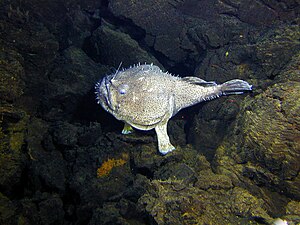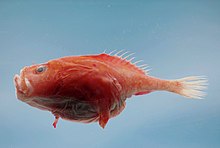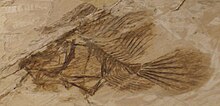Armless
| Armless | ||||||||||||
|---|---|---|---|---|---|---|---|---|---|---|---|---|

Indefinite anglerfish |
||||||||||||
| Systematics | ||||||||||||
|
||||||||||||
| Scientific name | ||||||||||||
| Lophiiformes | ||||||||||||
| Garman , 1899 |
The armfin fish (Lophiiformes) are an order of mostly curious-looking real bony fish , whose eponymous characteristic is the arm-like, stalked pectoral fins . With the exception of one species, the frogfish Antennarius biocellatus , which can also be found in brackish or fresh water , all armfin fish live in the sea, most of them in the deep sea . Some, especially the frogfish (Antennariidae), can also be found in the shallow water of tropical coral reefs . The armfin fish that live in shallow water are always benthic (living on the bottom), but most deep-sea species also live pelagic (in the open sea). In the Mediterranean only come monkfish before missing all other anglerfish. The habitat of deep-sea frogfish is in most cases between 800 and 2500 meters depth.
features
Armfinches show great variability in terms of body shape and can be rounded, elongated, laterally or dorsoventrally flattened. The head and mouth are usually large, the mouth, more precisely the premaxillary , can be extended (protractile). The teeth are numerous, small and arranged in several rows like a brush, but most deep-sea frogfish have only a few very elongated fangs. The palate is mostly toothed, but some deep-sea frogfish are edentulous. The eyes are usually quite large, but not in most adult deep-sea frogfish females.
The pectoral fins are heavily modified and arm-like (not in deep-sea frogfish). The throaty pelvic fins are also arm-like. They are supported by a fin spine and 4 to 5 soft rays and are absent in deep-sea frogfish (they are only still present in the larvae of the fan-finned fish).
In addition to the arm-like paired fins, the most striking feature of the order is a "fishing rod" ( Illicium ) formed from the first hard ray of the dorsal fin with attached "bait" ( Esca ), which is located on the snout or top of the head. It is absent in the male deep-sea frogfish and also in the females of Neoceratias spinifer . The Esca can be simple or very complex, and in most deep-sea frogfish it can also be bioluminescent . The fin support of the Illicium is strongly flattened, has a blade-like upper end, lies in a shallow hollow on the top of the skull and is highly mobile in some species.
The gill cover and cleft gill are reduced, and the cleft gill has become a small, tubular opening near the base of the pectoral fin. Gill trap rays on the first gill arch are missing. The ectopterygoid is Y-shaped. A pseudobranchy (eye gill gland) may be present or absent. The posterior temporal bone (post-temporal) has grown together with the skull. The swim bladder is usually absent; only some frogfish have a closed swim bladder. Of the hard rays of the dorsal fin, the first has been converted to Illicium , the second is reduced and lies under the skin of the head.
- Fin formula : dorsal 3–22, anal 3–19, pectoral 4–30, caudal 8–10.
Armfin fish are usually uniformly gray, brown or black in color, the frogfish that live in shallow water are often colorful and multicolored. Mostly they are small fish that reach body lengths of 10 to 25 cm. The monkfish, some frogfish, whip anglers, rod anglers and whip nose anglers can, however, get considerably larger. Anglerfish can reach lengths of over a meter and weigh up to 27 kg. Deep-sea frogfish show an extreme sexual dimorphism with dwarfish males , which can also live parasitically on the blood of the female.
The eggs hang together in a gelatinous, spiral-shaped mass or ribbon. The eggs and larvae are small, and the larvae head is relatively large.
External system
In the past the armfinches were assigned to the Paracanthopterygii together with other fish orders without fin spines . The frogfish (Batrachoidiformes) were considered their closest relatives. The Paracanthopterygii of that time, however, have proven to be a paraphyletic group. Modern molecular genetic studies clearly show that the armfin fish must be assigned to the perch relatives (Percomorphaceae) and are closely related to the puffer fish relatives (Tetraodontiformes) and the boar fish (Caproidae).
Internal system
Wiley and Johnson divide the armfinches into five subordinates. Theodore Pietsch and Christopher Kenaley give 18 families, 65 genera and 322 species. The deep-sea frogfish make up about half of the armfin fish species.
- Suborder Lophioidei
- Monkfish (Lophiidae)
- Suborder Ogcocephalioidei
- Sea bats (Ogcocephalidae)
- Suborder sensorfish-like (Antennarioidei)
- Frogfish (Antennariidae)
- Hand fish or wart anglers (Brachionichthyidae)
- Lophichthyidae
- Tetrabrachiidae
- Subordination Chaunacoidei
- Sea toads (Chaunacidae)
- Subordination deep-sea frogfish (Ceratioidei)
- Fanfloss (Caulophrynidae)
- Centrophrynidae
- Rod angler (Ceratiidae)
- Double angler fish (Diceratiidae)
- Whip nose angler (Gigantactinidae)
- Whip Angler (Himantolophidae)
- Devil Angler (Linophrynidae)
- Black angler or deep sea devil (Melanocetidae)
- Neoceratiidae
- Oneirodidae
- Thaumatichthyidae
The relationships according to a recent study shows the following cladogram :
| Lophiiformes |
|
||||||||||||||||||||||||
|
|
Fossil record
The armfinch fossil record is very sparse and so little is known of its tribal history. The earliest fossils come from the northern Italian Monte Bolca Formation, which was deposited in the early Eocene . Anglerfish, frogfish, hand fish and sea bats are known from this fossil deposit. The only known fossil deep-sea frogfish is Acentrophryne longidens (family Linophrynidae) from the late Miocene of California.
use
Apart from the anglerfish, which are valued as high quality food fish, the armfin fish have little or no economic importance. Some frogfish are caught for aquarium purposes, but in most cases they only live for a few months in an aquarium.
literature
Most of the information in this article is taken from the web site of the Armfinch expert Theodore W. Pietsch at the Tree of Life Web Project . In addition, the following sources were used:
- Joseph S. Nelson : Fishes of the World . John Wiley & Sons, 2006, ISBN 0-471-25031-7
- Kurt Fiedler: Textbook of Special Zoology, Volume II, Part 2: Fish . Gustav Fischer Verlag, Jena 1991, ISBN 3-334-00339-6
Individual evidence
- ↑ Antennarius biocellatus on Fishbase.org (English)
- ↑ Miya, Pietsch, et al .: Evolutionary history of anglerfishes (Teleostei: Lophiiformes): a mitogenomic perspective. BMC Evolutionary Biology, 10 (1), p.58, Feb 2010 doi : 10.1186 / 1471-2148-10-58
- ↑ Thomas J. Near, Ron I. Eytan, Alex Dornburg, Kristen L. Kuhn, Jon A. Moore, Matthew P. Davis, Peter C. Wainwright, Matt Friedman & W. Leo Smith: Resolution of ray-finned fish phylogeny and timing of diversification. PNAS , 2012, doi : 10.1073 / pnas.1206625109
- ^ EO Wiley & G. David Johnson: A teleost classification based on monophyletic groups . Pages 123-182 in Joseph S. Nelson , Hans-Peter Schultze & Mark VH Wilson: Origin and Phylogenetic Interrelationships of Teleosts . 2010, Verlag Dr. Friedrich Pfeil, Munich, ISBN 978-3-89937-107-9 .
- ↑ DeepFin.org: New and Revised Classification for Bony Fishes based on Molecular Data - version 2 ( Memento of the original dated December 12, 2013 in the Internet Archive ) Info: The archive link was inserted automatically and has not yet been checked. Please check the original and archive link according to the instructions and then remove this notice. (November 27, 2013)
Web links
- Armflosser on Fishbase.org (English)
- Lophiiformes. Anglerfishes (English), Theodore Pietsch, Christopher Kenaley, In The Tree of Life Web Project, 2005





